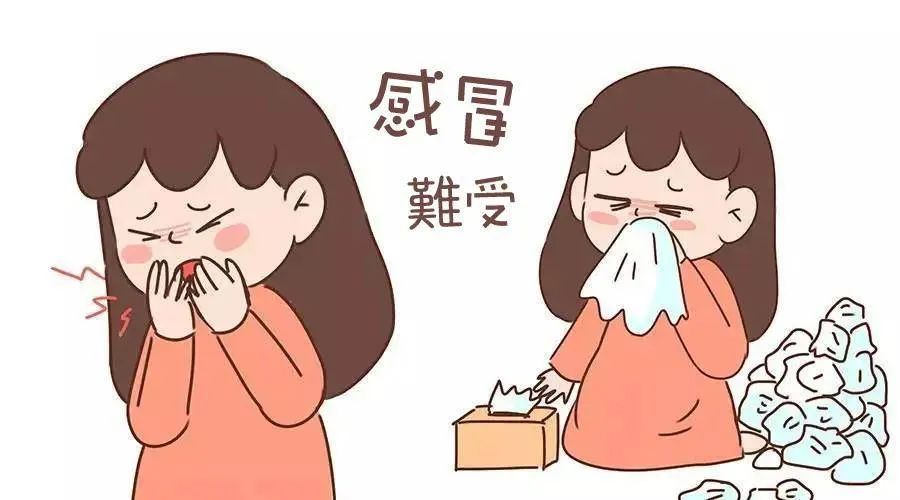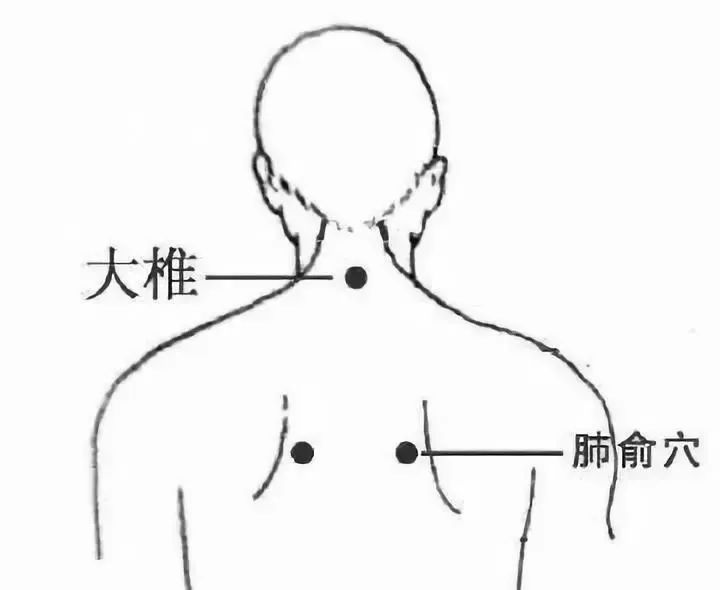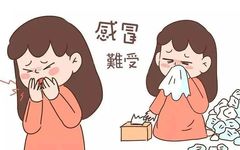Before reading this article, please click on the blue text above“Health Knowledge”, and then click“Follow”, so you can continue to receive articles for free. There are weekly shares. It is completely free to subscribe, so feel free to follow.
There are two states of an unhealthy body: one is cold; the other is heat. However, it is important to note that the states of cold and heat are not static; they are constantly changing, and the most prominent changes between cold and heat occur during a cold.In the past, TCM textbooks classified colds into wind-cold and wind-heat types, which I believe is incorrect. In fact, wind-cold and wind-heat are not different categories of colds, but rather different stages of a cold. A cold is caused by temperature changes leading to dysfunction in the body, and every person experiences both wind-cold and wind-heat stages during each cold. First, the initial response to a cold is to create a certain suppressive state in the body, with the most obvious manifestation being coldness on the surface, prompting one to bundle up. Sometimes, there is a runny nose and sneezing, which some refer to as a wind-cold cold; however, this is merely the initial stage of a cold. Why is this considered a suppressive state? Because at this time, the body is in a state of “insufficiency,” where qi and blood cannot supply the surface, making it unable to mount an effective defense, thus it is a “yin” state. This means that the yin energy begins to control the body, and yin energy has the characteristic of suppressive contraction.We learned in middle school physics that one of the properties of matter is thermal expansion and contraction. The human body is the same; when it is warm, the body expands and sweats; when it is cold, the body contracts, leading to goosebumps, sneezing, and a runny nose.In fact, the initial stage of a cold can sometimes be very short, lasting only a few hours or half a day. Because it is so brief, many people do not pay enough attention to it.It is important to note that this cold surface stage is crucial; at this time, the cold pathogen has not yet penetrated deeply, and the body’s resistance still has the ability to quickly eliminate it, so it is essential to seize this opportunity! What should be done? Quickly relieve the suppressive state!The method is actually quite simple; any warming food or drink can help, and sometimes even a cup of hot water is effective.Because the body is controlled by both yin and yang energies, but now the cold yin energy is becoming stronger, trying to control the body alone. The most direct method is to use warm items to increase the body’s yang energy, restoring the balance between yin and yang.Typically, using the white part of scallions (Allium fistulosum), cutting it up, adding a few slices of ginger (Zingiber officinale), and simmering it in water briefly until it boils is effective; do not simmer for too long, as we want its stimulating components. As Wu Jutong said, “When the aroma is strong, take it immediately; do not over-boil, as lung medicines should be light and clear; overcooking will thicken the flavor and affect the middle jiao.”It should be noted that scallions and ginger are both warming foods; once they enter the body, they will increase the yang energy within. When the yang energy is sufficient, the body will heat up and sweat, thus restoring the balance of yin and yang energies.Why should scallions and ginger not be boiled for too long? Because at this time, the cold pathogen is only on the surface, belonging to the lung meridian, and the lung meridian should disperse the cold. What does disperse mean? We often say to promote or spread, meaning to expand outward.What is easy to disperse? Light substances are the easiest to disperse, like air. Therefore, when scallions and ginger are lightly boiled, their aroma is light and clear, and once they enter the body, it is like a warm wind blowing, quickly eliminating the cold pathogen from the lungs.I also often recommend using perilla leaves (Perilla frutescens) steeped in water to dispel surface cold pathogens. Perilla leaves, also known as purple perilla leaves, can be purchased dried at pharmacies. You can prepare a small bag in the office; if you feel a cold coming on and suddenly feel cold, immediately steep it in boiling water for six to seven minutes before drinking.In ancient times, herbs like Ephedra (Ma Huang) and Cinnamon Twig (Gui Zhi) were used to address this issue, but they are not commonly used now.However, if you are truly shivering with cold and have no sweat at all, then you should use the Ma Huang Decoction from the “Treatise on Cold Damage”. Usually, using perilla leaves, scallions, etc., is sufficient; once you feel warm and no longer feel cold, that is enough. It is best to sweat slightly, but do not sweat profusely, and do not stand in a draft immediately afterward.
First, the initial response to a cold is to create a certain suppressive state in the body, with the most obvious manifestation being coldness on the surface, prompting one to bundle up. Sometimes, there is a runny nose and sneezing, which some refer to as a wind-cold cold; however, this is merely the initial stage of a cold. Why is this considered a suppressive state? Because at this time, the body is in a state of “insufficiency,” where qi and blood cannot supply the surface, making it unable to mount an effective defense, thus it is a “yin” state. This means that the yin energy begins to control the body, and yin energy has the characteristic of suppressive contraction.We learned in middle school physics that one of the properties of matter is thermal expansion and contraction. The human body is the same; when it is warm, the body expands and sweats; when it is cold, the body contracts, leading to goosebumps, sneezing, and a runny nose.In fact, the initial stage of a cold can sometimes be very short, lasting only a few hours or half a day. Because it is so brief, many people do not pay enough attention to it.It is important to note that this cold surface stage is crucial; at this time, the cold pathogen has not yet penetrated deeply, and the body’s resistance still has the ability to quickly eliminate it, so it is essential to seize this opportunity! What should be done? Quickly relieve the suppressive state!The method is actually quite simple; any warming food or drink can help, and sometimes even a cup of hot water is effective.Because the body is controlled by both yin and yang energies, but now the cold yin energy is becoming stronger, trying to control the body alone. The most direct method is to use warm items to increase the body’s yang energy, restoring the balance between yin and yang.Typically, using the white part of scallions (Allium fistulosum), cutting it up, adding a few slices of ginger (Zingiber officinale), and simmering it in water briefly until it boils is effective; do not simmer for too long, as we want its stimulating components. As Wu Jutong said, “When the aroma is strong, take it immediately; do not over-boil, as lung medicines should be light and clear; overcooking will thicken the flavor and affect the middle jiao.”It should be noted that scallions and ginger are both warming foods; once they enter the body, they will increase the yang energy within. When the yang energy is sufficient, the body will heat up and sweat, thus restoring the balance of yin and yang energies.Why should scallions and ginger not be boiled for too long? Because at this time, the cold pathogen is only on the surface, belonging to the lung meridian, and the lung meridian should disperse the cold. What does disperse mean? We often say to promote or spread, meaning to expand outward.What is easy to disperse? Light substances are the easiest to disperse, like air. Therefore, when scallions and ginger are lightly boiled, their aroma is light and clear, and once they enter the body, it is like a warm wind blowing, quickly eliminating the cold pathogen from the lungs.I also often recommend using perilla leaves (Perilla frutescens) steeped in water to dispel surface cold pathogens. Perilla leaves, also known as purple perilla leaves, can be purchased dried at pharmacies. You can prepare a small bag in the office; if you feel a cold coming on and suddenly feel cold, immediately steep it in boiling water for six to seven minutes before drinking.In ancient times, herbs like Ephedra (Ma Huang) and Cinnamon Twig (Gui Zhi) were used to address this issue, but they are not commonly used now.However, if you are truly shivering with cold and have no sweat at all, then you should use the Ma Huang Decoction from the “Treatise on Cold Damage”. Usually, using perilla leaves, scallions, etc., is sufficient; once you feel warm and no longer feel cold, that is enough. It is best to sweat slightly, but do not sweat profusely, and do not stand in a draft immediately afterward.

Another method is to place a hot water bottle in the bed, near the back at the location of the lung shu points, which are located on either side of the spine near the lungs.The hot water bottle should be positioned neither too far nor too close to avoid burning the skin; this can help promote the generation of yang energy while sleeping, changing the suppressive state within the body.This stage is what TCM refers to as the external cold stage.If coughing occurs at this time, one can choose the Chinese patent medicine Tongxuan Li Fei Wan. This formula primarily consists of warming herbs that can help the body organize its defenses; remember not to use cold or cooling medicines.If the external cold stage is handled promptly, based on my experience, the cold can be resolved within a day. If you do not pay attention, the cold pathogen will continue to penetrate, quickly leading to the internal heat stage.What is the internal heat stage? As the external pathogen penetrates, the body’s resistance begins to engage in a fierce battle with the external pathogen, and many areas of the body become battlegrounds. The manifestations at this time are typical heat symptoms: red and sore throat, fever, joint pain, coughing, etc.; diagnostic indicators include yellow phlegm, yellow nasal discharge, sore throat, and elevated body temperature. Everyone must remember these indicators; I often analyze the condition through phlegm and nasal discharge.What should be done at this stage? When the tonsils are inflamed and coughing begins, it can be extremely uncomfortable!At this time, one should use cooling methods to clear internal heat.A simple combination of medicines is: Shuanghuanglian Oral Liquid, which contains honeysuckle (Lonicera japonica), Scutellaria baicalensis, and Forsythia suspensa, collectively known as Shuanghuanglian.If it is severe, I recommend that you go to the pharmacy to buy herbs to decoct; the following herbal tea formula is one I often use, which is from my grandfather, Mr. Wang Engge.This formula is used to treat sore throats, and I have added a dose of perilla leaves to help regulate the initial onset of a cold; you can refer to it.The basic formula is: 10 grams of honeysuckle, 15 grams of forsythia, 6 grams of saposhnikovia, 3 grams of peucedanum, 10 grams of white silkworm (crushed), 10 grams of common purslane, 10 grams of dandelion, 6 grams of belamcanda, and 6 grams of perilla leaves (the perilla leaves should be added after the decoction is done, steep for ten minutes).If there is coughing and yellow phlegm, you can also add 10 grams each of Zhejiang fritillary (Fritillaria thunbergii) and loquat leaves (Eriobotrya japonica).The white silkworm in this formula is very effective for alleviating sore throats. After decocting the medicine, it should be consumed like tea, drinking it warm and continuously; it cannot be taken just twice a day, as this will not sustain the medicinal effect. Therefore, I call this formula a medicinal tea formula, and it should be treated as tea.This formula aims to dispel external cold while simultaneously clearing internal heat, and it is derived from Zhang Zhongjing’s Ma Xing Shi Gan Decoction, which is quite effective. If local doctors can adjust it according to individual constitution, that would be even better; pregnant women should avoid it.Since this is a heat syndrome, why add perilla leaves to dispel the exterior? This is based on my experience; colds generally do not present as purely heat syndromes; there is always some degree of external cold accompanying internal heat, so it is necessary to combine exterior dispelling methods; otherwise, the effect will not be good.If it is truly a case of pure internal heat syndrome, then the illness must be extremely serious.In general, drinking a few doses of such Chinese medicine can resolve internal heat.If the internal heat stage is handled promptly, based on my experience, the cold can generally be resolved within two days (some people may experience a gradual reduction in symptoms over several days), and it will definitely not progress further.However, some people are heavily influenced by Western ideas, believing that there is no special medicine for colds and that it will naturally resolve in seven days.Not long ago, I watched a program on CCTV where three experts from a major hospital in Beijing discussed colds, and two of them said, “A cold just requires drinking more water and resting for seven days, and it will resolve on its own. This is how it is done in America too.”After hearing this, I felt quite uncomfortable; in terms of scientific technology, America is certainly more advanced than us; but in terms of health preservation, America cannot compare to us, because we have thousands of years of wisdom in health preservation.

